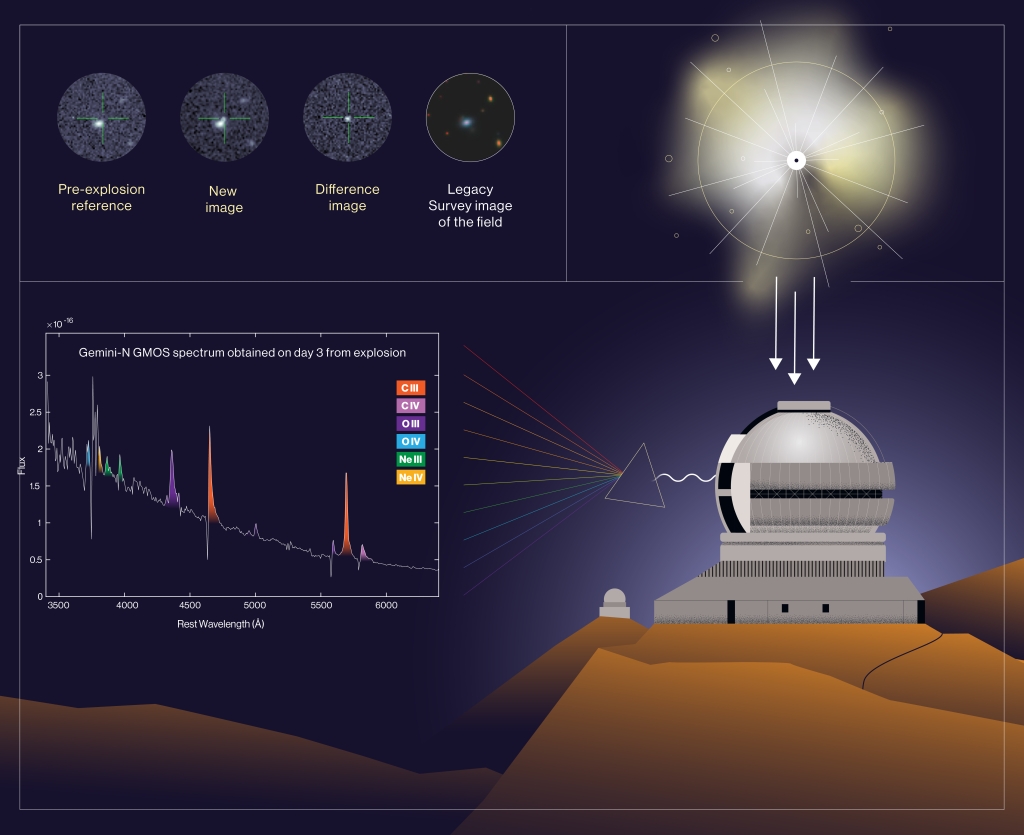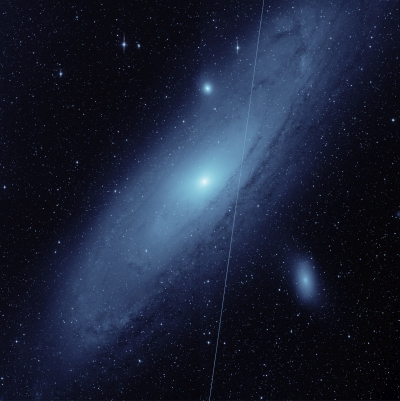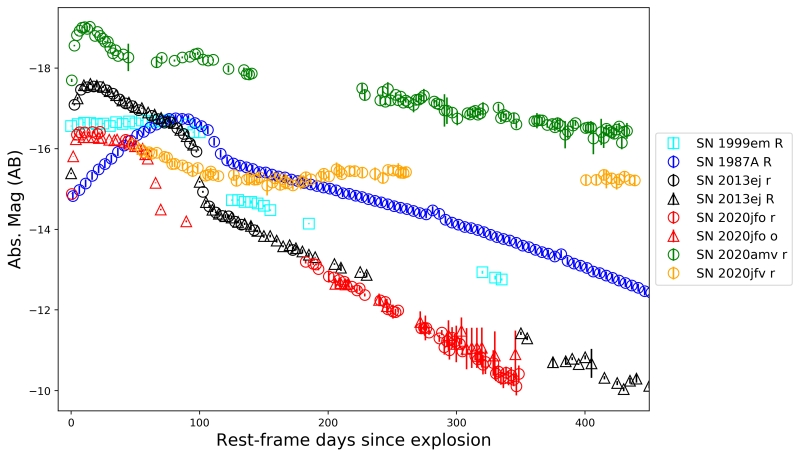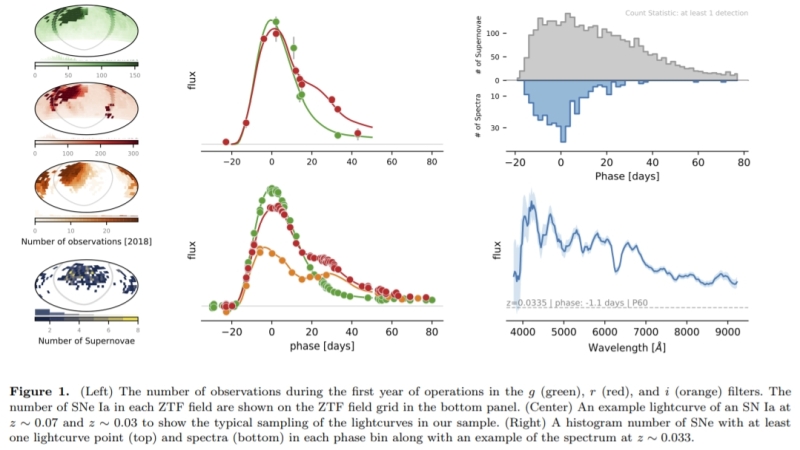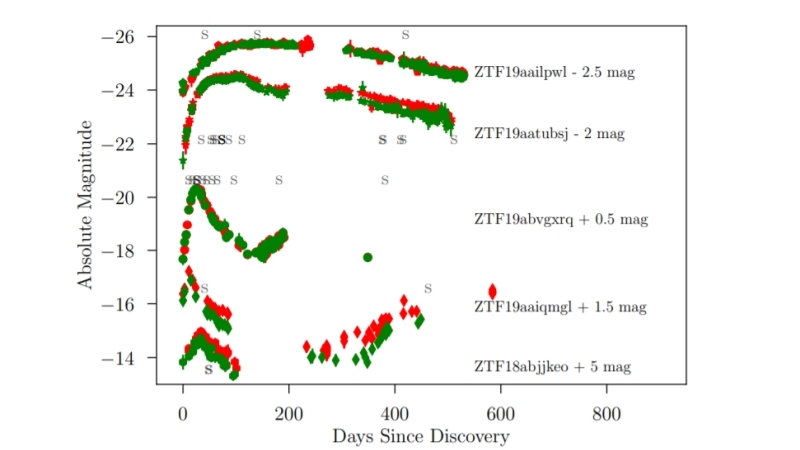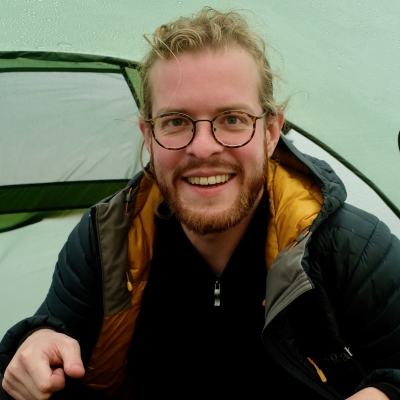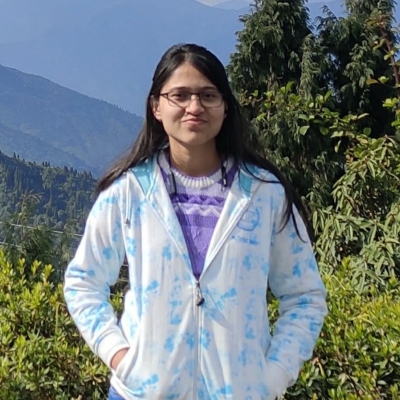ZTF Public Data Release 9
The Zwicky Transient Facility (ZTF) and IPAC at the California Institute of Technology announce the ninth ZTF Public Data Release. This release adds 2 months of observations to the eighth data release, up to 5 November 2021 for the public portion of the survey, and private survey time prior to 5 July 2020. Access to the data products is available via the on-line and API services of the NASA/IPAC Infrared Science Archive (IRSA).
Science Highlights
First Wolf-Rayet Star Observed as Supernova
Gal-Yam, Avishay et al, Nature 601, 201-204 (2022)
Led by ZTF partners at the Weizmann Institute, astronomers have, for the first time, discovered evidence that extremely massive stars such as Wolf-Rayet stars can explode as supernovae at the end of their lives. So far, the conventional thinking was that these stars quietly collapse to black holes without emiting any light. The discovery was first made with the ZTF on June 8th 2019 and swiftly followed up by more detailed observations with larger telescopes around the world. The study, published on Jan 12 in the journal Nature reveal a more complicated picture about the fates of such stars at the end of their lives. While many can turn into black holes as expected, we now know that at least some of them can take a different path and explode as supernova. It's also possible that the outer parts result in a supernova, while the inner core collapses into a black hole.
You can read the official press release and watch lead author Avishay Gal-Yam present at the 239 AAS press conference on Jan 12. Another finding of a peculiar supernova with ZTF, led by Daniel Perley (LJMU, UK) adds further evidence that massives stars die differently.
Press ReleaseZTF Analyzes Impact of Starlink Satellites
Looking back at archival ZTF images from the last two years, ZTF team member Przemek Mroz and an assistant professor at the University of Warsaw shows an increase in satellite streaks from the SpaceX Starlink fleet. The study is published this month in the Astrophysical Journal.
Supernovae with nebular hydrogen emission
Led by collaborators at our partner the Oskar Klein Center, the University of Stockholm in Sweden, this paper presents an extensive analysis of a core-collapse supernova with nebular hydrogen emission. The result illustrates how the absence or presence of interaction with circumstellar material affects both the light-curve and the nebular spectra of the supernova in particular.
First ZTF Type Ia supernova data release
An extensive report on the dataset of Type Ia supernovae discovered in the first year of ZTF operations is now published on Arxiv. Within the first 12 months of operations, ZTF has discovered more than 3000 supernovae and the sample described in this paper includes 761 spectroscopically classified SNe Ia, which is already comparable in size to the entire combined literature low-z anchor sample. T
Optical transients in Seyfer 1 galaxies
This study looks at five events discovered by ZTF that belong to an emerging class of active galactic nuclei (AGNs) undergoing smooth, large-amplitude, and rapidly rising flares.The authors hypothesize as to why NLSy1s are preferentially the sites of such rapid enhanced flaring activity.
ZTF Faces
Simeon Reusch
(DESY, Germany)
I come from the south of Germany (Swabia), and I am doing my PhD at DESY, a research center near Berlin.
Read OnKritti Sharma
(IITB, India)
My hometown is Chandigarh, which is primarily famous for being the first planned city of India with distinctive architecture and eternal greenery.
Read OnZTF Science Vlog
The ZTF vlog brings you the latest ZTF results presented by the authors themselves.
Discovering microlensing events with ZTF
In this ZTF Science Vlog, lead author and Caltech PhD student Tony Rodriguez speaks about the first systematic search of microlensing event in the ZTF public data.
Discovery of a stellar mass black hole candidate with ZTF
In this edition of our science vlog, Caltech PhD student Yuhan Yao talks about the discovery of a stellar mass black hole candidate and the possibility to find such objects directly in the optical, thanks to synoptic surveys such as the ZTF.
Science with public ZTF data
We highlight scientific publications from individuals and groups outside of the ZTF partnership that use ZTF public data
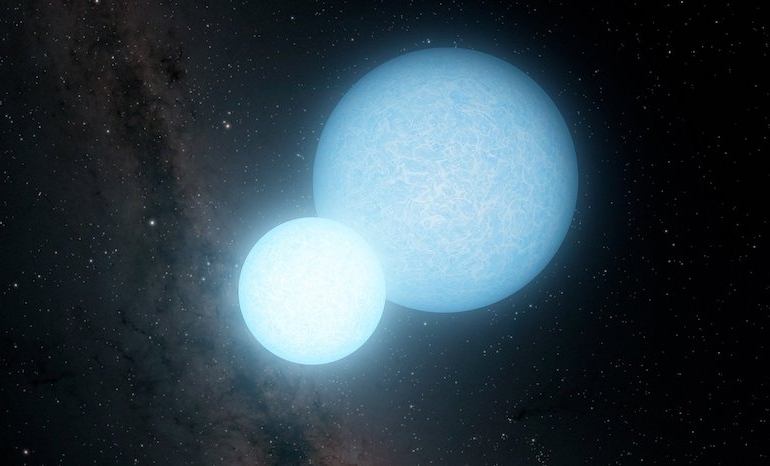
Artistic expression of an eclipsing white dwarf binary. Image credit: Caltech/IPAC/R.Hurt
Eclipsing white dwarf binaries in Gaia and the Zwicky Transient Facility
In this paper, we present 17 new eclipsing white dwarf binary systems that were discovered using astrometric data from Gaia along with photometric data from ZTF’s third public data release. Our search exploits light curve statistics and a Box Least Squares algorithm to detect periodic light curve variability. The new systems are characterised using spectroscopy and their positions on the Gaia H-R diagram. While most systems have main sequence companions, we also identify a candidate eclipsing white dwarf-brown dwarf binary and two extremely low mass (ELM) white dwarf binaries.
--Pascal Keller
University of Cambridge, UK
'How-to' Guide
Data quality in the ZTF single-exposure photometry catalog
The fully robotic nature of the ZTF survey affects the accuracy of the derived photometric calibration solutions. You can learn about the metrics applied to flag data as "unusable" and how to structure your queries to the photometry catalog such that you omit such data in section 2.4 of our ZTF Data System Cautionary Notes
ZTF is supported by the National Science Foundation and a collaboration including Caltech, IPAC, the
Weizmann Institute for Science, the Oskar Klein Center at Stockholm University, the University of
Maryland, Deutsches Elektronen-Synchrotron and Humboldt University, Lawrence Livermore National
Laboratory, the TANGO Consortium of Taiwan, the University of Wisconsin at Milwaukee, Trinity College
Dublin, IN2P3, University of Warwick, Ruhr University Bochum, and Northwestern University . Operations are conducted
by COO, IPAC and University of Washington.
Any opinions, findings, and conclusions or recommendations expressed in this material are those of the
author(s) and do not necessarily reflect the views of the National Science Foundation.
